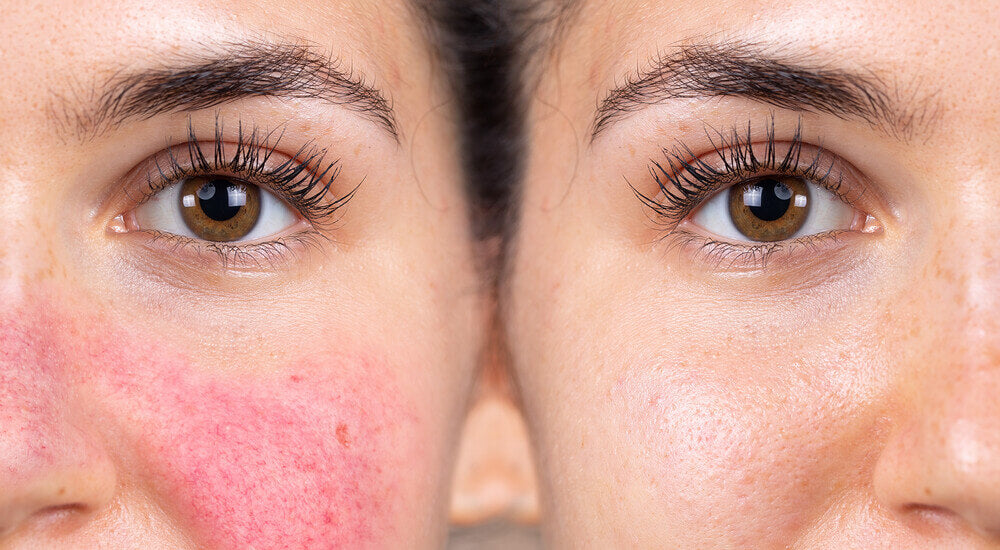Symptoms, causes, and how to handle an allergic reaction
Written by: 100% PURE ®
Flushing after cardio or a second glass of wine is one thing, but persistent irritation and facial redness can be just plain irritating. Adding to the madness is the attempt to figure out if your redness is from blotchy skin or something more sinister, like an allergic reaction.
While neither skin condition is pleasant, experiencing a skin reaction is going to require more than just the ice cube trick. We’ll give you the 411 on skin allergies, and tips on what to do to calm your complexion.
Does your face flush easily, and then stay that way for a while? At some point, most of us have experienced uneven skin tone known as blotchy skin. It’s common after cardio or cocktails, but long-term redness – combined with a rash and other noticeable changes on the skin – could mean something more.
Though you can have an allergic reaction on any part of your body, the face is a common site for reactions involving your skin. Depending on the cause of your allergy, your skin may appear with just a rash. But there can also be other physical signs that your skin is experiencing an allergic reaction.
#1. Itching
When you have itchy skin, the struggle is real. As most of us know, once you rub or scratch the area, it gets itchier. And the more it itches, the more you scratch. Repeated scratching can cause raised thick areas of skin that might bleed or become infected.
#2. Burning
A burning or stinging sensation is usually the partner in crime to hives. These skin culprits are an outbreak of raised, red bumps, splotches, or welts on the skin. The bumps are a result of histamine that the body releases in response to the allergen. Hives can be as small as a pen head or as large as a plate.
#3. Swelling
Whether you’ve itched your skin into swelling submission or get an unfortunate case of hives, swelling can occur deep under the skin. In the case of hives, swelling mostly occurs on the eyelids, lips, and throat, and may require immediate medical attention.
#4. Rash
Garden-variety rashes can come in all shapes, colors, and sizes. They can be very dry, smooth, bumpy, cracked, or blistered or be painful, itch, and even change color. The affected skin might be thickened or swollen, and have small, red, pus-filled bumps with oozing and crusting.
#5. Redness
Skin can be tinged with constant redness or blotches or flushing across your cheeks, nose, chin, or forehead. In many cases, it can feel hot to the touch, or may even be extra dry and chapped.

When life gets hectic, many tend to get a little lax with their skin care routine. This can affect the skin’s outer layer, leaving it vulnerable to irritants, blotchy skin and worse: an allergic reaction. Here are a few ways to get to the bottom of a skin reaction:
Tip 1:
Whatever’s causing your skin allergy, one thing is for certain: there are gentle, natural ingredients that can help. Opt for fragrance-free or minimally scented products until you’ve found the culprit of your allergic reaction.
Tip 2:
Assess and remove any new store-bought cosmetic products, which usually contain harsh or harmful ingredients. Fragrances and preservatives are usually the first skin offenders.
PRO-TIP: Always apply fragrance to your clothes, not your skin. This can help reduce the risk of an allergic reaction to the fragrance.
Tip 3:
Stay away from over-exfoliating, chemical peels, and harsh alcohols. The harshness or drying effects from these – plus alpha-hydroxy acids in peels – can cause blotchy skin and be problematic for some skin types.
Tip 4:
Identify and remove the products that are causing a skin reaction. Focus on swapping them out for gentler alternatives.
Tip 5:
Label claims like "hypoallergenic", "dermatologist tested”, or "non-irritating" do not guarantee that a product will suit your skin.
The good news is that many of the top offending causes of blotchy skin and a skin reaction can be managed with quick care or making some adjustments to your daily routine. If you should experience an allergic reaction, you can still work your way back to a calm complexion.
Wash skin ASAP
Immediately rinse the skin reaction area with water, or wash with a gentle fragrance-free cleanser. A cool compress can help calm a fiery rash.
Avoid UV rays
A little vitamin D is good, but not after an allergic reaction. Avoid immediate sun exposure or other activities that may worsen symptoms.
See a doctor
Talk to a doctor or dermatologist if blotchy skin or an allergic reaction is happening often or with more than one product, or the symptoms continue after discontinuing use of the product.
Take notes
Work to identify the ingredients causing the reaction. Introduce one product at a time and allow adequate time for any potential reaction before moving on to the next one. Keep a list!
Patch test
If you're trying a new product in the future – whether it be skin care, makeup, body care or hair care – patch test before use. Place a small amount on the inside of your elbow and wait 48 hours to 72 hours. If you have redness, swelling, itching, or burning, don't use that product.
Blotchy skin is a change in skin color due to a condition or a reaction to an ingredient. While most causes of blotchy skin or a skin reaction can be managed at home, there are rare cases that signal immediate medical attention or advice from a doctor.
While there may not be a one-size-fits-all fix for blotchy skin or an allergic reaction, we’ve found that treating skin with extra care will get you closer to a calm complexion.
- Tags: August-2021
We carefully hand-select products based on strict purity standards, and only recommend products we feel meet this criteria. 100% PURE™ may earn a small commission for products purchased through affiliate links.
The information in this article is for educational use, and not intended to substitute professional medical advice, diagnosis, or treatment and should not be used as such.

